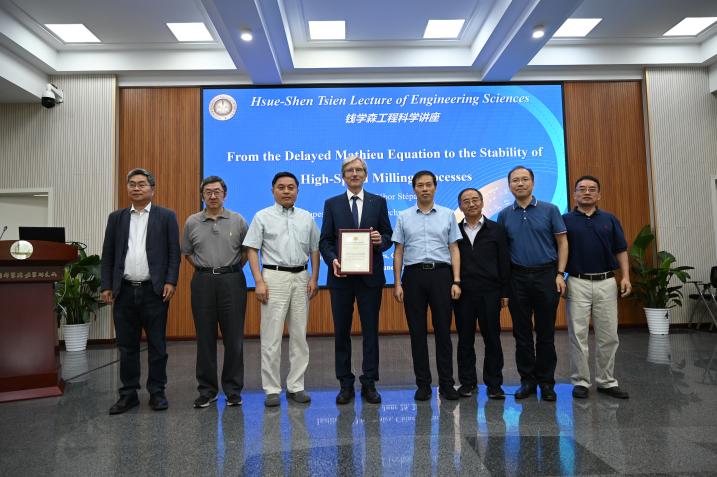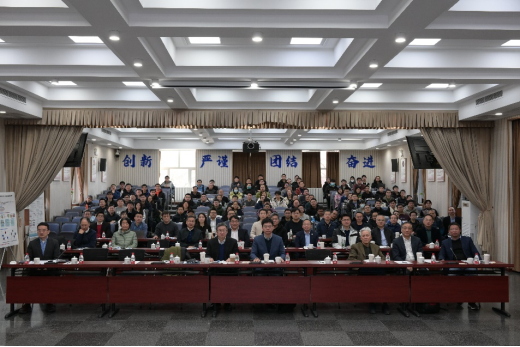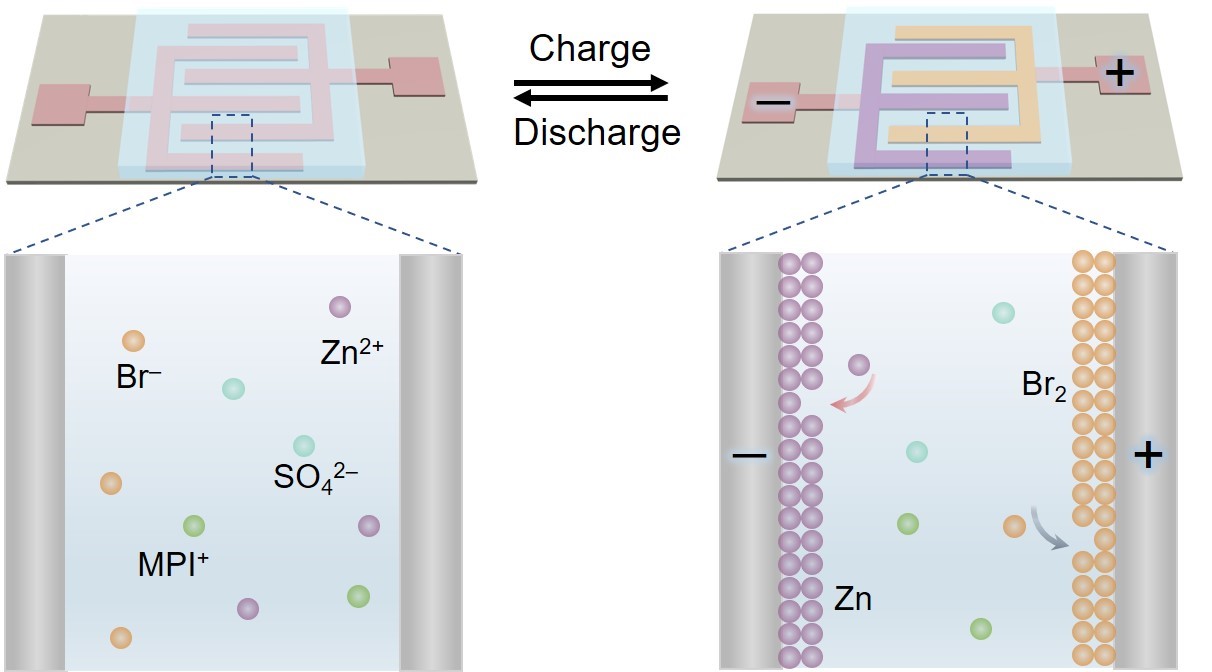Headlines
Academician Gabor Stepan from Budapest University of Technology and Economics Delivers Hsue-Shen Tsien Lecture of Engineering Sciences
On June 28th, Gabor Stepan, Academician from Budapest University of Technology and Economics in Hungary, was invited to visit the Institute of Mechanics (IMECH). He delivered a Hsue-Shen Tsien Lecture of Engineering Sciences titled "From the Delayed Mathieu Equation to the Stability of High-Speed Milling." Over 70 researchers and students attended, including Academician Hu Haiyan from Beijing Institute of Technology, Zhou Dejin, a senior staff member at the Academic Divisions of the Chinese Academy of Sciences, and Luo Xisheng, the director of IMECH, Academician He Guowei, the academic director of IMECH, and Yang Yongfeng, the Secretary of the Committee for Discipline Inspection of IMECH. The meeting was chaired by Professor Dai Lanhong.
Jun 28, 2024
2023 Academic Annual Conference of the State Key Laboratory of Nonlinear Mechanics
On December 22-23, 2023, the State Key Laboratory for Nonlinear Mechanics (LNM) of Institute of Mechanics (IMech), Chinese Academy of Sciences (CAS) held its Academic Annual Conference in Beijing. The event was attended by Prof. Wei Zhixiang, Deputy Director of Bureau of Frontier Science and Education, CAS; Zhang Junping, Director of the Department of Astronomic and Mechanics of the Bureau; Chen Hudong, Member of the National Academy of Engineering, USA; Prof. Wu Heng'an, Dean of the School of Engineering Science at the University of Science and Technology of China; Prof. Li Jiachun, Member of National Academy of Sciences, China; Prof. He Guowei, Member of National Academy of Sciences, China and Academic Director of IMech; Prof. Luo Xisheng, Director of the IMech; Ye Haihua, Secretary of the CDI, IMech.
Dec 29, 2023
The 6th International Conference on Droplets held in Beijing
Recently, the 6th International Conference on Droplets was successfully held in Beijing. The conference was jointly organised by the Institute of Mechanics, Chinese Academy of Sciences, Beijing University of Aeronautics and Astronautics and Tsinghua University, and co-organised by the Chinese Society of Mechanics. The conference was co-chaired by Professor Liu Qiusheng of the Institute of Mechanics, Professor Wen Dongsheng of the Beijing University of Aeronautics and Astronautics, and Professor Sun Chao of Tsinghua University. Over 130 professionals and academics from over ten countries, such as China, the USA, Germany, the UK, Japan, Singapore, India, etc., travelled to Beijing to attend the meeting.
Jun 20, 2023
The Institute of Mechanics has developed an ultra-strong tungsten high entropy alloy
Recently , the team of Lan-Hong Dai , Institute of Mechanics , Chinese Academy of Sciences , together with the University of California , Berkeley , Beihang University , Hong Kong Polytechnic University and City University of Hong Kong .The stepwise controllable precipitation structure realizes the ultra-high strength plasticity of tungsten high entropy alloy , which provides a new paradigm for the development of advanced materials .TEM images of dislocations shear γ " particles .
Jun 20, 2023
The Overstretch Strategy-A New Strategy to Double Stretchability of Stretchable Electronics
Stretchableelectronicshavebeenextensivelydevelopedinthelastdecadefordiverseapplicationsrangingfromhealthmonitoring,medicaltreatment,andintelligentindustriestoaerospaceequipmentwithstretchableorcurvilinearcharacteristics.Thekeytechnologicalinnovationininorganicstretchableelectronicsistheachievementofelasticstretchabilitythroughthedesignedmechanicalstructures,enablingconformalwrappingonarbitrarilycomplicatedtargetsurfaces,maintainingtheelectronicfunctionsunchanged.Forinstance,the“island-bridge”meshstructure,inwhichthefunctionalcomponentsresideatthe“islands”andtheinterconnectsformthe“bridges,”isthemostpopularone.The“islands”undergonegligibledeformationduringthestretchofthestructure,andthe“bridges”providebothelasticstretchabilityandelectronicconductivity.Strategiesforachievingelasticstretchabilityofstretchableelectronicsarecriticallyessentialandhaveattractedsignificantresearchattention.Althoughseveralpreviousstudieshavefocusedonthedesignofstretchablestructures,asshowninFigure1,onlytwofundamentalstrategieshavebeenexploitedtoachieveorenhanceelasticstretchability.Thesestrategiesaredescribedasfollows.1)Byusingtheprestrainedelasticsubstrate;awavedribbonisatypicalexample.Apre-strainisappliedtotheelasticsubstratebeforethestraightplanarribbonistransfer-printedandbonded.Thereleaseoftheprestrainyieldscompressionandout-of-planebucklingofthetransfer-printedribbon,formingawavedshapewithstretchablecharacteristics.Besides,morecomplexstretchable3Dmeso-structuresarefabricatedby2Dprecursorsbondedtoprestrainedelasticsubstrates.2)Bydesigninggeometriclayouts;versatilestretchablestructurelayoutsinvolvingcurvedinterconnectshavebeendesigned;theseincludehorseshoe,serpentine,fractal,non-buckling,helicalstructures,andkirigami-inspiredstructureswhichexhibitdifferentfeaturesintermsofelasticstretchabilityandapplicationscenarios.Sometimes,thetwotypesofstrategiesarecombinedtoenhancethestretchabilityofmechanicalstructures.Forinstance,aprestrainedelasticsubstratesignificantlyincreasesthestretchabilityofserpentinestructures.Recently,YewangSu'steamattheInstituteofMechanics,ChineseAcademyofSciences,innovativelyproposedathirdstrategytoimprovetheelasticstretchabilityofstretchableelectronics,i.e.,anoverstretchstrategy(Figure2).Thisstudyproposesoverstretchingbeyondthedesignedelasticrangeofstretchablestructures,appliedaftertransferprintingandbondingtothesoftsubstrate.Theoverstretchstrategycandoublethedesignedelasticstretchability,whichiscriticalfortheperformanceofstretchableelectronics.Thetheoretical,numerical,andexperimentalresultscollectivelyprovethattheoverstretchstrategyisvalidforvariousgeometricalinterconnectswithboththickandthincross-sections(Figure3,4,5).Theunderlyingmechanismisrevealedowingtotheevolutionoftheelastoplasticconstitutiverelationofthecriticalpartofthestretchablestructuresduringoverstretching.Theoverstretchstrategycanbeeasilyexecutedandcombinedwiththeothertwostrategiestoenhanceelasticstretchability,whichhasprofoundimplicationsforthedesign,fabrication,andapplicationsofstretchableelectronics.Theresearchresultsarepublishedintheacademicjournal“AdvancedMaterials”underthetitleof“AnOverstretchStrategytoDoubletheDesignedElasticStretchabilityofStretchableElectronics”(DOI:10.1002/adma.202300340).ThefirstauthorofthepaperisJuyaoLi,aPhDstudentattheInstituteofMechanics,ChineseAcademyofSciences,andthecorrespondingauthorisYewangSu,aresearcherattheInstituteofMechanics,ChineseAcademyofSciences,withtheparticipationofXiaoleiWu,aresearcherattheInstituteofMechanics,ChineseAcademyofSciences,inthework.ThisworkissupportedbytheNationalNaturalScienceFoundationofChina,the0to1OriginalInnovationProgramoftheChineseAcademyofSciences,CASInterdisciplinaryInnovationTeam,andtheWRQBTalentProgramoftheChineseMinistryofOrganization. Figure1.Evolutionofstretchablestructuresoverthepastdecades. Figure2.Operationoftheoverstretchstrategy.Thecolumnontheleft(Column1)showsthestep-by-stepoperationoftheoverstretchstrategy:①-②stretchingtothedesignedelasticlimit(58.5%),②-③stretchingbeyondthedesignedelasticlimit(140%),③-④releasingtheappliedstrain,④-⑤stretchingtoenhancedelasticlimit(117%).Columns2and3providethecontoursofthefiniteelementanalysis(FEA)forthemaximumprincipalstrainandequivalentplasticstrainoftheMTSIcorrespondingtoeachstepinColumn1,respectively. Figure3.MechanicalanalysisoftheoverstretchstrategyviathefreestandingMTSI.aMechanicalconstitutiverelationshipoftheMTSI:idealelastoplasticity.bSchematicandmechanicalmodelofthefreestandingMTSI.cFirstrow:step-by-stepoverstretchstrategyoperationwithfreestandingMTSI(oneperiod).Secondrow:stressdistributioninthecross-sectionofthesemicirclevertexineachprocessifnoadditionalplasticityoccursfromregime③to④.Thirdrow:stressdistributioninthesemicirclevertexcross-sectionineachprocessifadditionalplasticityoccursfromregime③to④.dEnhancedelasticstretchabilityofthefreestandingMTSIasafunctionofthemaximumofthefirstappliedstrain/over-strain,includingtheresultsoftheexperiments,FEA,andtheory. Figure4.ExperimentalverificationoftheoverstretchstrategyviathefreestandingMTSI.aImagesoftheinitialstateofthefreestandingMTSIandthefrontandsideviewswhenstretchedby150%(fromtoptobottom).bStress–straincurvesofadog-bone-shapedcopperplateinuniaxialtension.c-kCurvesoftheforceversustheappliedstrainduringthefirstappliedstretch,unloading,andsecondappliedstretch;thefirstappliedstrainforc–kis30%,50%,60%,75%,90%,110%,120%,130%,and150%,respectively(i-kcontaintheFEAresults,dottedlines). Figure5.MechanicalanalysisoftheMTSIbondedonthesoftsubstrate.a/b/cEnhancedelasticstretchabilityofthickhorseshoe/zigzag/fractalinterconnectsbondedonthesoftsubstrateasafunctionofthemaximumofthefirstappliedstrain/over-strain.dCurveofthedesignedelasticstretchabilityofserpentineinterconnectionbondedonthesoftsubstrateasafunctionofitsthickness.e-gFEAresultsofserpentineinterconnectionswiththreetypicalthicknesses.Theuppersubgraphsarethecorrespondingwrinkling,buckling,andnon-bucklingdeformationduringstretching,andthelowersubgraphsshowtherelationshipbetweentheenhancedelasticstretchabilityofthestructureandthemaximumofthefirstappliedstrain/over-strain.hSchematicofthedeformationmodesofthepartialsemicircleforthethickandthininterconnects. Originallink:AnOverstretchStrategytoDoubletheDesignedElasticStretchabilityofStretchableElectronics(wiley.com)
Jun 19, 2023
Researchers Propose Dual-plating Strategy to Fast Construct Microbatteries
High-performance,micro-sizedelectrochemicalenergystoragedevicesareessentialforfutureminiaturizedelectronicdevices,suchassmartmedicalimplants,wirelesssensors,andtheInternetofThings.Microbatteries[MBs]typicallyshowhigherenergydensityandmorestablevoltageoutputthanmicro-supercapacitors.However,currentMBsinvolvetediousconstructionproceduresandunsatisfactoryelectrochemicalperformance.Inaddition,allavailableconstructionmethodscouldnotmanipulateorbuildaliquidmicroelectrode.However,currentMBsinvolvetediousconstructionproceduresandunsatisfactoryelectrochemicalperformance.Inaddition,allavailableconstructionmethodscouldnotmanipulateorbuildaliquidmicroelectrode.AjointresearchteamledbyProf.QULiangtifromTsinghuaUniversity,Prof.ZHANGZhipanfromtheBeijingInstituteofTechnology,andProf.LIUFengfromtheInstituteofMechanicsoftheChineseAcademyofSciences(IMCAS)recentlyproposedadual-platingstrategytorapidlyconstructnewzinc–brominemicrobatteries(Zn–Br2MBs)withultrahigharealenergydensityandpolarity-switchablefunctionality.TheresultswerepublishedinScienceAdvancesonJuly13.Inthisstrategy,thein-situplatingofcathodesandanodesonmicroelectrodestakesplaceduringthechargingprocess,thuseliminatingthesynthesisofactivematerials.Furthermore,thetroublesomeandtime-consumingmassmatchingofcathodesandanodesinpreviousmethodscanalsobeavoided,astheyalwaysgenerateone-to-one.TheresearchersconstructedthefirstaqueousZn–Br2MBswithliquidcathodesbyusingredox-active1-methyl-3-propylimidazoliumbromide,whichnotonlypreventsdiffusionofBr3butalsoshowsfastkineticsduringcharginganddischarging.TheZn–Br2MBsshowedzero-excessofcathodeandanodeconfiguration.Theyalsodeliveredrecord-higharealcapacityandenergydensity,morethan10timesthatofmostplanarmicrobatteries.Zn–Br2MBsarepolarity-switchable,thusallowingself-rectificationduringpossiblefaultyoperationssuchaswronglyconnectingcathodesandanodesduringcharging.“ThecombinationbetweenthesuitablebindingstrengthandloosenetworkmicrostructuresinelectrodesendowsZn–Br2MBswithoutstandingperformance,”saidProf.LIU.Thisworkoffersnewinsightsforpromotingthedevelopmentofminiaturizedelectronicsthroughthefinedesignoftheirstates,mechanicalproperties,andmicrostructures.In-situconstructionoftheBr2cathodeandZnanodeduringthechargingprocess.(ImagebyIMCAS)
Jul 17, 2022
Professor Guowei He is elected as CAS member
ProfessorGuoweiHehasbeenelectedastheCASmember,thehighesthonorinthefieldofscienceinChina,theacademyannouncedonTuesday,Nov282017.GuoweiHeisafluiddynamicsscientistfromtheInstituteofMechanicsofChineseAcademyofSciences.HeobtainedhisPhDdegreefromtheNorthwesternPolytechnicUniversityofChinain1991.Hisresearchinterestliesinturbulencetheoryandcomputationalfluiddynamics.HisscientificachievementsincludetheEAmodelforspace-timecorrelationinturbulentflows,thespace-timecorrelationmethodforsub-gridscalemodelsoflarge-eddysimulation,theimmersedboundarymethodforbio-locomotion.HewasawardedasthefellowofAmericanphysicsSocietyin2015.Thecitationis“forfundamentalcontributionstounderstandingspace-timecorrelationsinturbulentflowsanddevelopmentoftime-accuratemodelsforlarge-eddysimulation”.
Dec 04, 2017
Foreign academicians of the American Academy of Engineering Emmanuel Detournay visits Institute of Mechanics
InvitedbyProfessorYapuZhao,EmmanuelDetournay,theforeignacademiciansoftheAmericanAcademyofEngineeringvisitedInstituteofMechanicsonOctober24th.HemadealectureonModelingandAnalysisofHydraulicFracturesinWeak,PermeableRocks.Inthelecture,PrfessorDetournaymadeadetailedanalysisofResearchprogressofhydraulicfracturinginshalegasexploitation.AndhemadeadeepdiscussionwithZheminZheng,YapuZhaoandotherresearchersinrelatedfields.PrfessorDetournaygavefullaffirmationtothecontributionofgroupZhao,theformationmechanismofhydraulicfracturingnetworkinshalegasexploitation.PrfessorDetournayistheexpertinhydraulicfracturing,drillingmechanicsandporouselasticfields.Duetohisoutstandingcontributions,hewaselectedasaforeignacademicianoftheAmericanAcademyofengineeringandamemberoftheAcademyofSciencesoftheRussianAcademyofSciences
Nov 27, 2017







